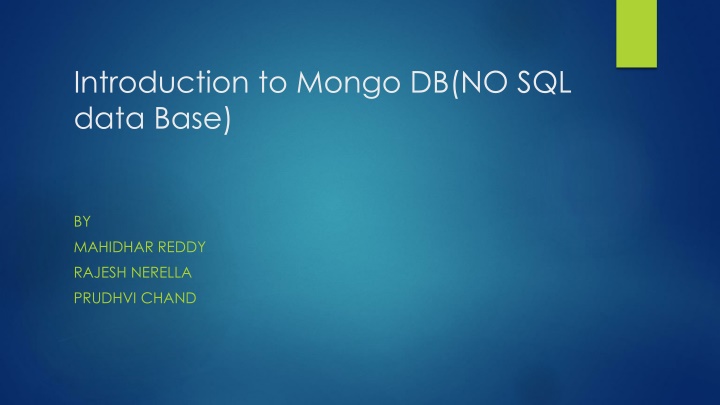
Introduction to MongoDB: A Detailed Overview of NoSQL Data
Explore the fundamentals of NoSQL databases, learn about MongoDB, its architecture, document structure, types of NoSQL databases, and the benefits of using MongoDB in modern applications. Understand the differences between JSON and XML, and discover when to utilize MongoDB for efficient data storage and retrieval.
Download Presentation

Please find below an Image/Link to download the presentation.
The content on the website is provided AS IS for your information and personal use only. It may not be sold, licensed, or shared on other websites without obtaining consent from the author. If you encounter any issues during the download, it is possible that the publisher has removed the file from their server.
You are allowed to download the files provided on this website for personal or commercial use, subject to the condition that they are used lawfully. All files are the property of their respective owners.
The content on the website is provided AS IS for your information and personal use only. It may not be sold, licensed, or shared on other websites without obtaining consent from the author.
E N D
Presentation Transcript
Introduction to Mongo DB(NO SQL data Base) BY MAHIDHAR REDDY RAJESH NERELLA PRUDHVI CHAND
Overview What is NO SQL Data base? Types of NO SQL Data base. What is Mongo DB? Why Mongo DB? Mongo DB Architecture. Document (JSON) Structure. Differences between XML and JSON. Different Methods. Demo When to use Mongo DB?
What is No SQl data base It s Not No SQL it s NOT ONLY SQL. It s not even a replacement to RDBMS. As compared to the good olden days we are saving more and more data. Connection between the data is growing in which we require an architecture that takes advantage of these two key issues.
Types of No SQl data base Document Based Key Value pair [ { "Name": "Tom", "Age": 30, "Role": "Student", "University": "CU", } ] (#key,#value) (Name, Tom) (Age,25) (Role, Student) (University, CU) Mango Db AmazonSimple DB Couch DB Dynamo DB Azure Table Storage (ATS ) Graph database Column Oriented database Row Id Columns Masters Tom Name Tom Bigtable(Google) Student Age 25 1 HBase Neo4j Infogrid CU 25 Role Student Location Ottawa
What is Mongo DB MongoDB is a cross-platform, document oriented database that provides High performance. High availability. Easy scalability. MongoDB works on concept of collection and document.
Why Mongo DB? All the modern applications deals with huge data. Development with ease is possible with mongo DB. Flexibility in deployment. Rich Queries. Older database systems may not be compatible with the design. And it s a document oriented storage:- Data is stored in the form of JSON Style.
Mongo DB architecture Architecture : - Database Document Container
Document(JSON) structure [ { "Name": "Tom", The document has simple structure and very easy to understand the content "Age": 30, "Role": "Student", "University": "CU", JSON is smaller, faster and lightweight compared to XML. } { For data delivery between servers and browsers, JSON is a better choice "Name": Sam", "Age": 32, "Role": "Student", Easy in parsing, processing, validating in all languages "University": OU", JSON can be mapped more easily into object oriented system. } ]
Difference Between XML And JSON XML JSON It is a markup language. This is more verbose than JSON. It is used to describe the structured data. JavaScript functions like eval(), parse() doesn t work here. Example: <car> <company>Volkswagen</company> <name>Vento</name> <price>800000</price> </car> It is a way of representing objects. This format uses less words. It is used to describe unstructured data which include arrays. When eval method is applied to JSON it returns the described object. { "company": Volkswagen, "name": "Vento", "price": 800000 }
Why JSON? JSON is faster and easier than XML when you are using it in AJAX web applications: Steps involved in exchanging data from web server to browser involves: Using XML Fetch an XML document from web server. 1. Use the XML DOM to loop through the document. 2. Extract values and store in variables. It also involves type conversions. 3. 4. Using JSON Fetch a JSON string. 1. Parse the JSON string using eval() or parse() JavaScript functions. 2.
The insert() Method Example: - db.StudentRecord.insert ( To insert data into MongoDB collection, you need to use MongoDB's insert() or save() method. { "Name": "Tom", "Age": 30, "Role": "Student", "University": "CU", }, { "Name": Sam", "Age": 22, "Role": "Student", "University": OU", } The basic syntax of insert() command is as follows db.COLLECTION_NAME.insert(document) )
The find() Method Example: - To query data from MongoDB collection, you need to use MongoDB's find() method. The basic syntax of find() method is as follows db.COLLECTION_NAME.find() find() method will display all the documents in a non-structured way. db.StudentRecord.find().pretty() To display the results in a formatted way, you can use pretty() method. db.mycol.find().pretty()
The remove() Method MongoDB's remove() method is used to remove a document from the collection. remove() method accepts two parameters. One is deletion criteria and second is justOne flag. Remove based on DELETION_CRITERIA db.StudentRecord.remove({"Name": "Tom}) deletion criteria (Optional) deletion criteria according to documents will be removed. Remove Only One:-Removes first record justOne (Optional) if set to true or 1, then remove only one document. db.StudentRecord.remove(DELETION _CRITERIA,1) Syntax Remove all Records db.COLLECTION_NAME.remove(DELLETI ON_CRITTERIA) db.StudentRecord.remove()
When to use Mongo Db? When your requirements has these properties : You absolutely must store unstructured data. Say things coming from 3rd-party API you don t control, logs whose format may change any minute, user-entered metadata, but you want indexes on a subset of it. You need to handle more reads/writes than single server can deal with and master-slave architecture won t work for you. You change your schema very often on a large dataset.
